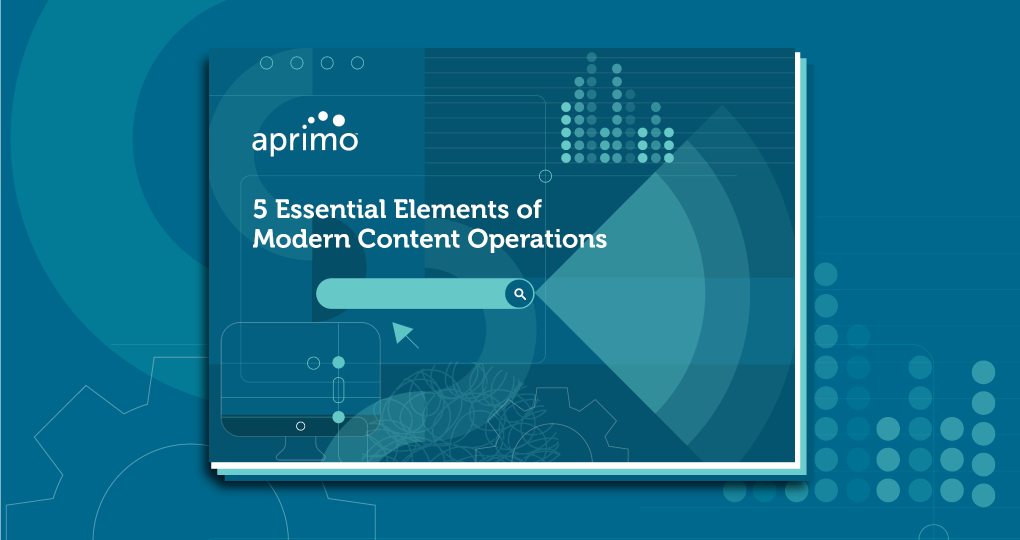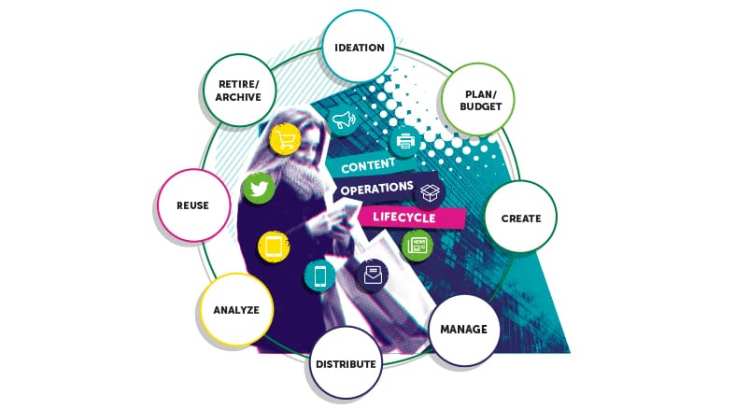Content has become the lifeblood of businesses aiming to establish a strong online presence and connect with their target audience effectively. However, as the volume of content grows, managing and optimizing it becomes increasingly complex. This is where content operations come into play. In this article, we will delve into the depths of content ops, its key components, benefits, implementation, challenges, and best practices.
What Is Content Operations?
Content operations is the set of processes, people, and technologies needed for strategically planning, creating, managing, and analyzing all content across channels to ensure it aligns with business objectives and delivers value to the audience.
It is, in essence, a framework for how an enterprise creates the content that powers its customer experiences (CX). But that’s just the beginning.
The Role of Content Operations in Content Management
Content operations act as the backbone of content management, enabling businesses to efficiently handle content throughout its lifecycle. From ideation to publication and beyond, content ops streamline the entire process, ensuring a consistent and coherent brand message across various channels. By optimizing the content workflow, businesses can reduce redundancy, improve productivity, and deliver high-quality content consistently.
How Content Operations Differ from Content Strategy
While content strategy focuses on defining goals, target audience, and the overall approach, content operations dive deeper into the execution and implementation of the strategy. It involves the practical aspects of content creation, distribution, and performance analysis. In other words, content operations take the content strategy blueprint and turn it into actionable steps to bring content to life.

Who Needs Content Operations?
Everyone can benefit from content operations software. Any business that wants to make an empathetic, human connection with their customers needs content operations software to make it happen.
Customers demand personalized experiences. In fact, 89% of digital businesses are investing in personalized content, including Coca-Cola, Fableticks, Netflix, Sephora, USAA, and Wells Fargo, according to research by Forrester.
Having a strong software solution solves fundamental challenges by empowering teams in every stage of content creation, from planning through performance analysis. Content ops helps marketing teams:
- Optimize planning and execution
- Maximize content creation efficiencies
- Optimize production workflows
- Manage content centrally, maximizing findability and usage
- Remain on-brand and compliant
- Gain confidence in how content contributes to the bottom line
Content has always been critical to business. Archaeologists have identified examples from as early as 35 B.C. of a fish sauce purveyor in Pompeii using product branding and content production to differentiate product types, presumably to reach customers more effectively.
The investment in building customer experiences is only expected to grow. Both businesses and customers agree that customer experience outweighs both price and product. 86% of customers would pay more for a better experience. 45.9% of business leaders report prioritizing customer experience over product (33.6%) and pricing (20.5%).
From blog posts to sales pitches, effective content is the means by which brands connect with customers. Without an optimized content operations solution in place, creating personalized content takes much more time and consumes many more resources. That’s why your framework is so important.
Benefits of Effective Content Operations
Improved Content Consistency and Quality
Content operations ensure that content is consistent in tone, style, and messaging. It helps maintain brand identity and fosters trust with the audience. Consistency also allows the audience to recognize and relate to the brand more easily. When content consistently meets or exceeds expectations, it contributes to building a loyal customer base.
Enhanced Collaboration and Workflow Efficiency
Content operations involve defining clear roles and responsibilities for team members involved in the content creation process. This clarity enhances collaboration, streamlines workflows, and reduces the risk of duplicated efforts or communication breakdowns. With efficient processes in place, content teams can work seamlessly, ensuring timely delivery of content.
Increased Audience Engagement and Conversion Rates
When content is tailored to the target audience’s needs and preferences, it leads to higher engagement and increased conversion rates, positively impacting the business’s bottom line. Content operations enable content creators to create more relevant and targeted content that resonates with the audience, prompting them to take the desired actions.

Implementing Content Operations in Your Business
Building a Content Operations Team
Establishing a dedicated team for content operations is essential for success. This team can consist of content strategists, writers, editors, designers, SEO specialists, and data analysts. Each team member plays a specific role in the content creation process, contributing their expertise to produce cohesive and effective content.
Selecting the Right Tools and Technologies
Leveraging content management systems (CMS), SEO tools, and analytics platforms enhances content operations’ efficiency and effectiveness. CMS facilitates content organization, collaboration, and publishing, while SEO tools and analytics provide valuable data for making data-driven content decisions.
Establishing Workflows and Processes
Creating streamlined workflows and clear processes helps avoid bottlenecks and ensures content moves smoothly through its lifecycle. Workflows should be designed to minimize delays, provide transparency, and facilitate collaboration among team members.
Getting Your Content Operations Strategy Right
Designing your content operations strategy takes an intimate understanding of the content operations ecosystem. You need to understand how the various elements of content ops connect both internally and externally with the enterprise’s broader operational units.
The core components of content operations include four primary capabilities.
- Digital Asset Management (DAM)
- Marketing Work Management (MWM)
- Strategic Planning
- Embedded Technologies
Together, these four components make up the basics of your content operations solution.
The larger ecosystem includes these core capabilities and two additional components: the content ops techstack and your core integrations.
Content operations is, at its core, about making the best use of cutting-edge technologies. By designing an effective tech stack?with a content operations solution as the proverbial meat and potatoes of the tech stack?and implementing the right integrations and marketing automations, you lay the groundwork for delivering generative, personalized customer experiences across channels.

Common Challenges in Content Operations
Overcoming Bottlenecks and Delays
Content operations can face delays due to approval processes, resource constraints, or ineffective workflows. Identifying and addressing these bottlenecks is crucial for maintaining content consistency. Regular evaluation of the content production process can help identify areas that require improvement and optimization.
Maintaining Content Relevance and Freshness
As audience preferences and market trends change, content must stay up-to-date and relevant. Content operations must address content refreshment to avoid stagnation. This involves revisiting and updating existing content to ensure it remains valuable and informative.
Managing Content Governance and Compliance
For businesses operating in regulated industries, content operations must adhere to compliance standards and governance policies. This includes ensuring the accuracy of information, copyright compliance, and adherence to industry-specific regulations.
Content Operations Best Practices
Adopting Agile Content Development
Embracing an agile approach allows content teams to adapt quickly to changes, respond to feedback, and continuously improve content quality. Agile content development empowers teams to be flexible, iterate on content ideas, and respond to emerging trends and opportunities promptly.
Utilizing Content Management Systems (CMS)
A robust CMS simplifies content organization, collaboration, and publishing, making content operations more efficient. CMS platforms provide a centralized location to manage content assets, streamline workflows, and ensure content is delivered on time.
Incorporating SEO and Keyword Research
Aligning content operations with SEO efforts ensures that content ranks well in search engines, driving organic traffic. Keyword research should inform content creation, and on-page optimization elements should be optimized for better search engine visibility.
Measuring Success in Content Operations
Defining KPIs for Content Performance
Setting clear key performance indicators (KPIs) helps measure the success of content efforts and identifies areas for improvement. Common KPIs may include website traffic, time on page, conversion rates, and social media engagement.
Analyzing Metrics and Data for Continuous Improvement
Data-driven insights allow content teams to identify content that resonates with the audience and optimize content strategies accordingly. Analyzing metrics and user behavior patterns can uncover valuable insights that inform content improvements and future content decisions.
Content Operations FAQs
Implementing content operations offers several key benefits. It ensures streamlined content creation and delivery, leading to increased efficiency and productivity. Content operations also improve content consistency and quality, enhancing the brand’s reputation and credibility. Moreover, it enables businesses to measure content performance and make data-backed decisions for continuous improvement.
Content strategy focuses on defining the overall goals, target audience, and approach for content creation. It sets the direction for content efforts. On the other hand, content operations involve the practical implementation of the content strategy, including content planning, creation, distribution, and analysis.
To streamline content operations, businesses should invest in essential tools like content management systems (CMS), SEO and keyword research tools, analytics platforms, collaboration and project management tools, and social media scheduling and monitoring tools.
Content operations play a crucial role in improving SEO efforts. By aligning content with SEO strategies, conducting keyword research, and optimizing on-page elements, businesses can improve search engine rankings and organic traffic. Additionally, content operations’ data analysis helps identify high-performing content and areas for SEO optimization.
Adopting content operations may present challenges such as resistance to change, team collaboration issues, resource constraints, and difficulties in measuring content ROI. Overcoming these challenges requires effective communication, change management, and a willingness to adapt to new workflows and technologies.
Get Started With Content Operations
Content impacts every business unit: Marketing, Product teams, Legal, Training, HR, eCommerce, and R&D. For this simple reason, having a content operations solution in place reliably improves a wide swath of the business.
Content operations play a pivotal role in enabling businesses to produce high-quality content that engages the target audience and drives business results. By implementing efficient workflows, selecting the right tools, and aligning content with SEO strategies, businesses can create a well-oiled content engine that consistently delivers valuable content to their audience.
The ever-evolving landscape of content marketing and technology will continue to influence content operations. As businesses embrace automation, AI, and data-driven insights, content operations will become more sophisticated, efficient, and targeted. Staying abreast of these trends and incorporating best practices will be crucial for businesses seeking to thrive in the digital content landscape.
Get started with a FREE trial of Aprimo digital asset management software.


